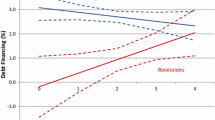Abstract
The level of UK corporate debt directly affects financial stability in the United Kingdom because a significant amount of the exposure of the UK financial system is to UK corporates. Our paper provides a comparison of the determinants of corporate debt in the United States, the United Kingdom, France and Germany. The comparison serves to benchmark our findings about the determinants of UK corporate debt. In addition, the UK financial sector is significantly exposed to the corporate sectors in the United States, Germany and France. The model assesses the contribution of investment, acquisitions, cash flows and market-to-book values to the determination of debt, and also the tendency of debt to revert to its optimum level. Debt was found to be positively related to the financing needs of the firm, and the optimum level of debt to be negatively related to the market-to-book ratio. This casts some light on the procyclicality of debt.
Similar content being viewed by others
References
Antoniou A., Guney Y., Paudyal K.: Determinants of corporate capital structure: evidence from European countries. University of Durham Business School, Working Paper, Durham (2002)
Antoniou A., Guney Y., Paudyal K.: The determinants of corporate capital structure: capital market-oriented versus bank-oriented institutions. J Financ Quant Anal 43, 59–92 (2008)
Antoniou A., Guney Y., Paudyal K.: The determinants of debt maturity structure: evidence from France, Germany and the UK. Eur Financ Manag 12, 161–194 (2006)
Arellano M., Bond S.: Some tests of specification for panel data: Monte Carlo evidence and an application to employment equations. Rev Econ Stud 58, 277–297 (1991)
Arellano M., Bover O.: Another look at the instrumental variable estimation of error components model. J Econom 68, 29–51 (1995)
Arulampalam W.: A note on estimated coefficients in random effects probit models. Oxf Bull Econ Stat 61(4), 597–602 (1999)
Barclay M., Smith C., Watts R.: The determinants of corporate leverage and dividend policies. J Appl Corp Financ 7(4), 4–19 (1995)
Benito, A., Young, G.: Financial pressure and balance sheet adjustment by UK firms. Bank of England Working Paper no. 168 (2002)
Bernanke B., Gertler M.: Financial fragility and economic performance. Q J Econ 105, 87–114 (1990)
Blundell R., Bond S.: Initial conditions and moment restrictions in dynamic panel data models. J Econom 87, 115–143 (1998)
Blundell R., Bond S., Devereux M., Schiantarelli F.: Investment and Tobin’s Q. J Econom 51, 233–257 (1992)
Calomiris C.W., Himmelberg C.P., Wachtel P.: Commercial paper, corporate finance, and the business cycle: a microeconomic perspective. Carnegie-Rochester Conf Ser Public Policy 42, 203–250 (1995)
Campbell J.R., De Nardi M.: A conversation with 590 nascent entrepreneurs. Ann Financ 5, 313–340 (2009)
De Nardi M., Villamil A.: Entrepreneurship, finance and employment. Ann Financ 5, 289–293 (2009)
Doornik, J.A., Arellano, M., Bond, S.: Panel data estimation using DPD for OX, Unpublished. Available at http://www.doornik.com/research.html (1999)
Engle R.F., Granger C.W.J.: Cointegration and error correction: representation, estimation and testing. Econometrica 55, 251–276 (1987)
Fama E., French K.: Testing trade-off and pecking order predictions about dividends and debt. Rev Financ Stud 15(1), 1–33 (2002)
Friderichs, H., Paranque, B., Sauve, A.: Structures of corporate finance in Germany and France: a comparative analysis for West German and French incorporated enterprises with special reference to institutional factors. In: Sauve, A., Scheuer, M. (eds.), Corporate finance in Germany and France. Working Papers—Yale School of Management’s Economics Research Network (1999)
Gomes, A., Phillips, G.: Why do public firms issue private and public securities? NBER Working Paper 11294, April (2005)
Guilkey D.K., Murphy J.L.: Estimation and testing in the random effects probit model. J Econom 59, 301–317 (1993)
Harrison R., Nikolov K., Quinn M., Ramsey G., Scott A., Thomas R.: The Bank of England Quarterly Model. Bank of England, London (2005)
Hendry D.F.: Dynamic Econometrics. Oxford University Press, Oxford (1995)
Herranz N., Krasa S., Villamil A.P.: Small firms in the SSBF. Ann Financ 5, 341–359 (2009)
Huang R., Ritter J.R.: Testing theories of capital structure and estimating the speed of adjustment. J Financ Quant Anal 44, 237–271 (2009)
Jensen M.: Agency costs of free cash flow, corporate finance and takeovers. Am Econ Rev 76, 323–329 (1986)
La Porta R., Lopez-de-Silanes F., Shleifer A., Vishny R.W.: Law and finance. J Polit Econ 106, 113–1155 (1998)
Margi S.: The financing of small entrepreneurs in Italy. Ann Financ 5, 397–419 (2009)
Myers S.: Determinants of corporate borrowing. J Financ Econ 5, 147–175 (1977)
Myers S., Majluf N.: Corporate financing and investment decisions when firms have information that investors do not have. J Financ Econ 13, 187–221 (1984)
Rajan R., Zingales L.: What do we know about capital structure? Some evidence from international data. J Financ 50, 1421–1460 (1995)
Shyam-Sunder L., Myers S.: Testing static tradeoff against pecking order models of capital structure. J Financ Econ 51, 219–244 (1999)
Welch, I.: Columbus’ egg: the real determinant of capital structure. NBER Working Paper no. 8782 (2002)
Welch I.: Capital structure and stock returns. J Polit Econ 112(1), 106–131 (Part 1) (2004)
Author information
Authors and Affiliations
Corresponding author
Additional information
The views expressed in this paper are those of the authors, and not necessarily those of the Bank of England. This paper was completed while P. Gibbard was at the Bank of England.
Rights and permissions
About this article
Cite this article
Gibbard, P., Stevens, I. Corporate debt and financial balance sheet adjustment: a comparison of the United States, the United Kingdom, France and Germany. Ann Finance 7, 95–118 (2011). https://doi.org/10.1007/s10436-010-0146-6
Received:
Accepted:
Published:
Issue Date:
DOI: https://doi.org/10.1007/s10436-010-0146-6




